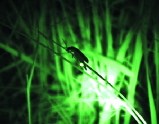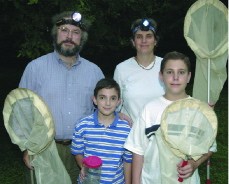One knew, perhaps, that the gas nitric oxide (NO) is a constituent of automobile exhaust and a big player in the formation of smog, and is no laughing matter, such as nitrous oxide, N2O. But who knew that NO is crucial chemistry in the flash of a firefly as it searches for sex (or dinner) in the dark of a summer night?
 |
| Female firefly gives a flash response to suitor. |
| S. Lewis |
Sara M. Lewis '75, BI '90, associate professor of biology at Tufts University, and spouse Thomas Michel '77, M.D., associate professor of medicine at Harvard Medical School and chief of cardiology at the Harvard-affiliated West Roxbury VA Hospital, have collaborated with scientists of other disciplines and with their sons, specimen collectors Benjamin and Zachary, to show that a firefly uses nitric oxide to control the flash of its lantern, a spectacular natural phenomenon. This is the same molecule, Michel notes, "that in humans controls blood pressure, penile erection, and the formation of memories, among diverse other roles."
Nitric oxide, a small, diffusible, highly reactive molecule, is often deployed by the body as a biological signal and regulator. Michel and colleagues at Harvard-affiliated Brigham and Women's Hospital were able to describe how the gas helps control blood pressure by dilating blood vessels. Naturally, he talked about his work at the dinner table with Lewis, who is an evolutionary ecologist and insect neurophysiologist interested in fireflies. The couple and Barry Trimmer, a biologist colleague at Tufts, wondered whether nitric oxide might have something to do with how fireflies turn their lanterns on and off. The three of them asked June Aprille, a cell biologist at Tufts, for her thoughts on the matter. The four roped in David Dudzinski, a student at Harvard Medical School, to build a tiny gas chamber for firefly research. These four, with three others, in time announced flash findings in Science magazine. "No single one of us could have made the discovery," says Michel, "and ours is a nice example of the power of interdisciplinary collaboration."
Thousands of specialized light-producing cells called photocytes in the lantern of the fireflya beetle, actually, not a flyhave in their inner regions structures that contain chemicals that generate light when turned on by oxygen. But the edges of the photocytes are also densely packed with organelles called mitochondria, "which are quite famous as the oxygen-consuming power plants of almost all cells," says Aprille. Ordinarily, the mitochondria use up the oxygen piped in through tracheal air tubes to make energy for all cellular activities. But when the firefly wants to flash, it generates a nerve pulse that releases nitric oxidethe team found the enzyme that produces NO lying right next door to the firefly's light-generating apparatusand when NO is present, the use of oxygen by the millions of respiring mitochondria comes, say the scientists, to a screeching halt. Oxygen is then able to pass through the mitochondria to the interior of the cell where it reacts with the light-producing chemicals to produce luminescence. Flash. As the NO signal decays, the mitochondria power up again and begin to gobble up oxygen, which turns the lantern off. All of this happens in a fraction of a second.
 |
| Thomas Michel and Sara Lewis, with their sons, Zachary (left) and Benjamin, poised for research en famille outside their home in Lincoln, Massachusetts. |
| Jon Chase / Harvard News Office |
"What is life? It is the flash of a firefly in the night," said the dying Blackfoot warrior Crowfoot. Yes, but what is the meaning of the flash? "Fireflies are very romantic beasts," says Lewis. "Their whole adult life is spent courting." The courtship system is based on flash communication. A firefly can flash once a second, and each flash lasts about half a second. All of the hundreds of known species of firefly time their flashes differently for identification purposes, and male and female flash patterns within species also differ. Thus, one species will flash at a regular, sedate rate, while another will emit a periodic machine-gun burst of multiple flashes. Flashes, some fireflies learn, aren't always an invitation to the dance. Female Photuris fireflies know how to imitate the flashes of females of other species, luring males of those species, whom they eat. All that glitters is not gold.
Who knew what a gas is nitric oxide? "Only within the past dozen years have we begun to learn the major role that nitric oxide plays in the internal regulatory system of human beings," says Michel. "It is at work in the heart, blood vessels, brain, penis, liver, lungs, eyes, and likely in every other human organ." In many of its good works, it functions as a relaxer. Thus, release of NO in the kidneys relaxes the smooth muscle in the walls of blood vessels, increasing blood flow and, thereby, the rate of filtration. Nitroglycerine, often prescribed to reduce the pain of angina, works by generating nitric oxide, which relaxes the walls of the coronary arteries. During sexual excitation, nerve endings near the blood vessels of the penis release NO, allowing the vessels to relax and blood to pool, producing an erection. (Viagra® works by amplifying the effects of nitric oxide.)
According to the self-styled home page of NO (www.academicpress.com/no/), "From diabetes to hypertension, cancer to drug addiction, stroke to intestinal motility, memory and learning disorders to septic shock, sunburn to anorexia, male impotence to tuberculosis, there is probably no pathological condition where nitric oxide does not play an important role."





